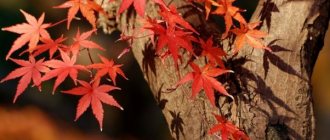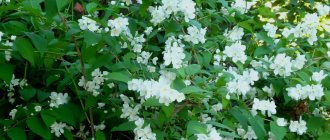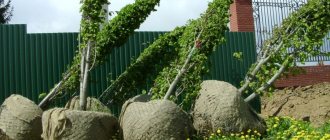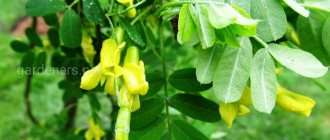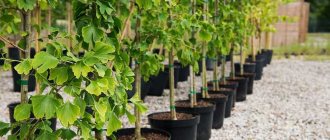Trees and shrubs
Anastasia Zemlyanichko 07/26/2018 no comments
1
( 18 ratings, average: 4.31 out of 5)
- 1 Barberry 1.1 Gallery: red-leaved trees and shrubs (25 photos)
Autumn is the brightest and most beautiful period, when your garden is transformed in a matter of days, changing the color of the foliage from green to brown, yellow and red. How can one explain such a variety of colors?
The thing is that the chlorophyll contained in summer foliage is replaced by other substances: anthocyanins and carotenoids. With the arrival of autumn, the supply of nutrients in trees gradually decreases, as a result of which the synthesis of chlorophyll also stops. At this time, other pigments contained in the leaves become noticeable - orange, yellow (carothionides) and red (anthocyanins).
Many gardeners purposefully plant ornamental plants on their plots that will make the garden attractive in the fall. Ornamental trees and shrubs stand out for their beauty and brightness of color, unusual foliage color and amazing fruits.
Barberry
This is one of the most common and popular shrubs, widely used to decorate the autumn garden. The plant has excellent decorative qualities, and it is also very unpretentious. Some species of this shrub have an unusual bright red tint of leaves and the same color of berries, while others acquire a burgundy color with the arrival of autumn (Thunberg barberry).
Thanks to its decorative properties, barberry looks great both in single and group plantings. In addition, this plant is widely used as a hedge.
Shrubs with red berries do not need pruning, but shaping the crown makes them more spectacular.
The most common varieties of these shrubs are Ottawa barberry and Thunberg barberry. They get along well with conifers such as pine, thuja, and juniper.
Good autumn compositions are obtained from barberry and yellow deciduous shrubs.
Dwarf barberry is used to create miniature compositions in a rocky garden, on a lawn, and also as a border or mixborder. When forming a composition of several plants, it is advisable to follow a simple rule: the variety of forms should be visible from any corner of the garden.
You can purchase this spectacular ornamental shrub at any garden center.
Do not underestimate the role of shrubs in the garden plot. After all, thanks to them, the garden looks more comfortable and lived-in. Such plants smooth out sharp edges well, and their amazing leaves do not require constant care.
Gallery: red-leaved trees and shrubs (25 photos)
kak.hepcinatvp.ru
08/22/2019 admin Comments No comments
Why do leaves change color in autumn?
fall1 300×225 Why do the leaves change color in autumn?
Plant leaves are green because they contain chlorophyll, a pigment found in plant cells. A pigment is any substance that absorbs visible light. Chlorophyll absorbs sunlight and uses its energy to synthesize nutrients.
But in autumn, plant leaves lose their bright green color.
For example, poplar leaves turn golden, while maple leaves seem to flash red. Some chemical transformations begin in the leaves, that is, something happens to chlorophyll. With the arrival of autumn, plants prepare for winter. Nutrients slowly move from the leaves to the branches, trunk, and roots and are stored there during severe cold weather. When spring arrives, plants use stored energy to grow new green leaves.
When the energy of stored nutrients is depleted, chlorophyll synthesis stops. The chlorophyll remaining in the leaves partially disintegrates, and pigments of a different color are formed. Yellow and orange pigments appear in the leaves of some plants. These pigments consist mostly of carotenes, the substances that give carrots their orange color. For example, the leaves of birch and hazel become bright yellow as chlorophyll disintegrates; the leaves of some other trees acquire various shades of red.
The red, dark cherry and purple hues of some leaves are due to the formation of anthocyanin pigment. This pigment colors radishes, red cabbage, roses and geraniums. Under the influence of autumn cold, chemical reactions begin in the leaves, converting chlorophyll into red-yellow compounds. Unlike carotenes and other yellow pigments, anthocyanin is generally absent in green leaves. It is formed in them only under the influence of cold. The color of autumn leaves, like the color of human hair, is determined genetically in each plant species. But whether this color will be dull or bright depends on the weather.
The brightest, richest colors of the leaves occur in autumn, when cold, dry and sunny weather lasts for a long time (at temperatures from 0 to 7 degrees Celsius, the formation of anthocyanin increases). There are beautiful fall leaf colors in places like Vermont. But, for example, in Great Britain, where the climate is rainy and the weather is cloudy almost all the time, autumn leaves are most often dull yellow or brown. Autumn passes, winter comes. Along with the leaves, the plants also lose their colorful colors. The leaves are attached to the branches by special cuttings. With the onset of winter cold, the connection between the cells that make up the cuttings disintegrates. After this, the leaves remain connected to the branch only by thin vessels through which water and nutrients enter the leaves. A slight breath of wind or a drop of rain can break this ephemeral connection, and the leaves will fall to the ground, adding another touch of color to the multi-colored thick carpet of fallen leaves.
Plants store food for winter, like chipmunks and squirrels, but they accumulate it not in the ground, but in branches, trunks and roots.
The leaves, into which water stops flowing, dry out, fall from the trees and, caught by the wind, circle in the air for a long time until they settle on the forest paths, lining them with a crisp path. The yellow or red coloration of the leaves may persist for several weeks after they have fallen. But over time, the corresponding pigments are destroyed. The only thing that remains is tannin (yes, this is what colors the tea). ..
Red maple
These ornamental garden trees are native to northeastern Canada and southeastern Asia. Red maple is widely used by gardeners to create landscape designs. Seedlings of this tree can be purchased at any specialized nursery. The red leaf maple has a showy crown and purple leaves in the fall. The shape of the crown is determined by the variety and can be ovoid, round or columnar.
The Japanese have long been engaged in the selection of red maple, as a result of which many varieties of this tree were born.
The most spectacular and beautiful of them are the following varieties:
- Shirasawa maple;
- palm-shaped (fan-shaped);
- Japanese red maple.
Does not like direct sunlight , so it is better to plant it not in an open area, but in partial shade. These trees look good in combination with dark conifers, and can also decorate a recreation area (patio) located next to the house.
Since this type of maple came to us from the east, it is an ideal option for decorating an Asian-style garden. Under the unique crown of this tree you can plant flowers that grow well in shade and partial shade.
The red-leaved maple has large buds of a bright red hue, so its decorative qualities are manifested not only in the autumn, but also in the spring.
Landing Features
Planting a Royalty apple tree has its own characteristics:
- Deadlines. Seedlings are planted in the spring, before the buds open, or in the fall, before frost occurs (2 months before).
- Site preparation. The hole for planting a tree must be prepared in advance. The best option is 1 month before planting. The plant must be planted in prepared soil. The apple tree does not like too wet, rocky or dry sandy soil. A hole 1 m deep and 80 cm wide is sufficient.
- Selection of seedlings. Choose healthy plants without spots, scratches, signs of disease or other damage. The root system should be strong and powerful, and the branches should grow at an acute angle.
Southern Mackerel
In nature, this plant is found in regions with a very warm climate: in the Caucasus, Crimea, on the Mediterranean coast and southern Russia.
With the onset of autumn, the leaves of this shrub acquire a purple, orange or burgundy hue (the color is determined by the variety). First, reddening of the veins is observed, after which the entire leaf turns bright red.
Mackerel is widespread in central Russia, where it is used as an ornamental plant. Looks good both in single and group plantings and forms spectacular hedges. It is recommended to grow the plant in sunny areas protected from the wind . Mackerel is resistant to disease, quite hardy, and is rarely affected by pests.
Trimming and shaping the crown enhance the decorative properties of the bush. Here you can most often find the following types of scumpia:
- Purpureus;
- Flame;
- Grace.
Rouyal Purper is a very popular variety in Europe, but in cooler climates it may freeze slightly.
If your garden plot has rocky soils or slopes, it is better to place it there, and it will serve as an excellent decoration for the landscape. In addition to the pleasant color of beautiful autumn leaves, this shrub will delight the eye during flowering - fluffy pink panicles are formed from the inflorescences, making the mackerel even more elegant and beautiful.
If your choice falls on this tall shrub, you should keep in mind that the plant grows quite quickly, so it requires space . Over time, a small seedling will turn into a small tree or a spectacular spreading bush.
How to care for trees?
In order for the tree to grow spreading and powerful, it is necessary to provide high-quality care. Without care and attention, red-leaved ornamental apple trees lose their impressive appearance and turn into an ordinary dull apple tree.
To maintain its original appearance, it is recommended to follow the following care rules:
| Care | Rules |
| Top dressing | It should be applied with knowledge of the qualities and type of soil. If the soil is sandy, then in the spring you will need additives with a large amount of nitrogen, but such fertilizing is not suitable for black soil. Foliar application of nutrients should also be carried out. It is necessary to fertilize the first leaves, then during flowering and fruit formation. In summer it is necessary to feed every 2 weeks. And in the fall, carefully monitor the plant and track what is missing for the normal growth of the apple tree. |
| Watering | You should not constantly add nutrient moisture when water is at hand. For proper watering, just adding moisture 3 times is enough, but provided that the soil is saturated approximately 80-90 cm deep. Watering is carried out: in early summer, with the beginning of flowering, then in mid-July, when the fruits form. The latter should be carried out in October, for moisture-recharging irrigation before frosts. |
| Loosening around the trunk | This is necessary to remove weeds, as well as to loosen the crust on the surface from periodic watering, which blocks the possibility of normal oxygen supply to the rhizomes. |
Decorative apple tree
This tree can rightfully be called Russian sakura - it is magnificent during the flowering period, as it is dotted with a huge number of pink flowers, and when the time comes for the fruits to ripen and they acquire a red tint, perfectly combining with the color of the foliage, this small tree looks very impressive.
The red-leaved apple tree looks especially good in single plantings, but several trees planted along a fence or along a path look just great.
A decorative apple tree will help to place the necessary accents on the garden plot and even highlight a shaded corner.
It should be noted that this species stands out for its unpretentiousness , as well as resistance to adverse weather conditions . This tree is not afraid of severe frosts , so it can be grown even in very harsh climates.
Today, there are many varieties of ornamental apple trees that can rightfully occupy a central place in your garden plot. The color of the petals and leaves can be different, as well as the shape of the crown, therefore, before choosing one or another, you should carefully study all the varieties and characteristics of this tree.
Among the many varieties of ornamental apple trees, the following can be distinguished:
- Riverside, or weeping;
- Royal Beauty;
- Royalty;
- Nedzvetsky;
- Pioneer.
Reproduction
There are several main ways to propagate ornamental varieties of apple trees. The easiest way is to buy seedlings at the market or in a special store so that you can plant them without the hassle.
But for those who are not looking for easy ways, there are several ways:
- using seeds. They are collected from the fruits, planted and preserved until the seedlings emerge. However, not all characteristics of a variety are transmitted in this way when propagated;
- vaccinations. An effective method if the procedure is carried out correctly;
- cuttings A method that has been familiar to everyone for a long time, but which does not guarantee that it will take root.
Cherry plum (red-leaved plum)
This is another of the most popular varieties of red-leaved trees, characterized by its unpretentiousness and excellent decorative qualities. Cherry plum has dark burgundy fruits and leaves of the same color. In addition, the red-leaved plum is famous for its good fruiting and lends itself well to cutting and shaping: you can make a beautiful spherical crown.
The tree looks great in a single planting, and also looks impressive as a hedge, the height of which can vary from 60-70 cm to 2 m and above. Cherry plum, like the ornamental apple tree, is resistant to various diseases and pests .
Pest Control
Pepin saffron apple tree: description of the variety
A beautiful variety of apple trees, Pink Fairy Tale, can transform any garden. But in order for trees to be happy for a long time, you need to properly care for them. Special means are used to prevent diseases and pests.
A rash on the trunk, leaves or fruits is a sign of disease or pests
In spring, treatment should be carried out before the buds appear. For this, insecticides or Bordeaux mixture are used. During flowering, copper sulfate is added - it increases resistance to fungal diseases.
Karbofos is effective against insects. Treatments cannot be carried out every day, the frequency between them is 2-3 weeks. Otherwise, you can harm the trees.
Important! All drugs must be diluted in accordance with the instructions.
After flowering, it is recommended to treat the apple tree with complex preparations. If traces of rot or spots appear on fruits or leaves, the cause must be determined. Then look for ways to combat pests or diseases. For example, powdery mildew occurs when humidity is high. In this case, you need to drain the apple trees or drain the water. Then remove the damaged parts of the tree.
Decorative apple trees decorate the garden. With proper care, they will delight you for years. You can also collect fruits from them.
Red oak
This tree is an excellent solution for decorating a garden plot. Red oak is called Canadian (or holly).
If you have chosen this particular tree, you should remember that oak needs space , so it can only be planted in a large area.
In general, the plant is unpretentious and can grow on any soil except limestone . It is also necessary to monitor the amount of moisture, since oak does not tolerate waterlogging . In the first years, it is recommended to cover the tree for the winter.
Flowers
Rainbow eucalyptus flowers are unusual.
They have no petals or sepals. However, they do have stamens and a pistil. The stamens are the male reproductive organs and the pistil is the female organ. Flower buds take the form of a capsule containing the stamens and pistil. The capsule has a conical cover called the operculum. When the bud matures, the operculum becomes dark and wrinkled.
After pollination and fertilization, the capsule becomes a woody fruit containing seeds.
The name "eucalyptus" comes from two Greek words - "es", which means "good", and "kalyptos", which means "covered".
Leaves and oil
Eucalyptus leaves are leathery and hang from the branches. They are often long, narrow and spear-shaped, although some species have wider and rounder leaves. Some species of eucalyptus produce copious amounts of oil that is volatile as well as aromatic. When a large number of trees grow close to each other, the evaporated oil sometimes forms a mist in the air.
Red-leaved beech
The following varieties of this plant exist:
- Weeping beech. The tree reaches a height of 1-1.5 m, has an arched crown and dark red foliage in autumn.
- Forest beech. Reaches a height of 20 m, the foliage color is dark red.
If you like ornamental plants and want to create an original garden, you should definitely pay attention to trees and shrubs with red foliage. In the summer-autumn period, they will help to place the necessary accents in your garden plot, as well as create spectacular compositions. The garden will look more elegant and brighter, and red-leaved fruit plants (apple tree, plum tree, barberry) will be able to please you with delicious fruits in the fall.
1
( 18 ratings, average: 4.31 out of 5)
Back
Drip irrigation in a greenhouse
MORE
All about pruning
Pruning is carried out so that the plants do not thicken themselves in the first place, so as not to provoke the development of diseases that form due to the lack of ventilation inside the skeletal branches.
Several types of pruning are carried out: formative, rejuvenating and sanitary.
The latter is most often carried out in the fall to prepare the plant for wintering without the presence of pests. It is also necessary to remove excess growth in the spring. During the winter, the tree may suffer from a large volume of snow mass and some of the branches may break off.
Crown formation is carried out using several methods. The following forms can be formed in a plant:
- Tiered discharged.
- Fusiform.
- Cup-shaped.
- Vertical palmette.
The main thing is that all methods are aimed at providing the plant with the correct balance between the central part (trunk) and the branches extending from it.
Trees in autumn description. Sunday walk in the forest in autumn (essay)
Autumn is a wonderful and very surprising time of year! There are trees around with yellowed and half-fallen leaves, and under your feet lies a huge carpet, full of a crazy variety of all bright and rich shades. And it’s even better if such wonderful landscapes are accompanied by the autumn sun, which no longer burns like in summer, but only slightly caresses and warms.
In such weather it would be unforgivable to sit at home; the best thing to do would be to take a walk. And the best day for a walk will be Sunday. A day off when you don’t need to rush or rush anywhere, but can take a measured and sedate walk through the autumn forest.
Such a walk evokes romantic images and is suitable for both a child and an old man. It would be best to take a walk alone to think about life, reflect on your worldview and admire the beauty of nature falling asleep for the winter. It’s still warm, there’s no cold or frost, but a slight chill has already forced people to put on jackets and scarves. The walk will be very captivating and will be remembered for a long time. The sky may not be overcast, but delight with its blueness and small clouds. Migratory birds are already flying south in their schools.
What deep thoughts about life are evoked by autumn nature, painted in different colors. There are so many divine shades here! There is yellow, and orange, and red, and even remnants of green. And all this abundance of flowers, a riot of colors surrounds us on all sides. It is these cozy walks in silence and solitude that will help you relieve stress, focus on something important to yourself, take a break from the bustle of the big city and retire to yourself.
Sunday walks in the forest, of course, can be carried out at any other time of the year, but autumn gives them a special charm and splendor, because autumn is the sunset of nature, which follows its long winter sleep.
Which shrubs with “silver” foliage are not afraid of our winter?
First of all, these are small willows, for example, and. creeping 'Argentea', etc. Swiss, and woolly. They are ideal for small gardens. Reliable and unpretentious, silver oleagin is a medium-sized frost-resistant shrub with beautiful “aluminum” leaves. In harsh winters, its taller cousin, the angustifolia oleaginus, often freezes the ends of its shoots, but this does not affect the decorative appearance of the plant. All these shrubs are light-loving, drought-resistant and do not tolerate stagnant moisture.
| Unpretentious ornamental shrubs | ||
| Leaf color | Large | Compact |
| Yellow | Luteus 'Dart's Gold' 'Golden Nugget', red elder 'Plumosa Aurea', 'Sutherland Gold', elderberry 'Aurea', black elderberry 'Aurea', common hazel 'Aurea', white turf 'Sibirica' Aurea' | Thunberg's barberry 'Tiny Gold' 'Maria', 'Aurea', 'Bonanza Gold', red elderberry 'Golden Locks' |
| Purple and red | Ottawa barberry 'Superba', 'Silver Miles', Thunberg barberry 'Atropurpurea', Viburnum foliage 'Diabolo', 'Diable D'Or', 'Summer Wine', common hazel 'Atropurpurea' | Thunberg's barberry 'Atropurpurea Nana', 'Dart's Red Lady', 'Orange Rocket', 'Rose Glow', 'Red Pillar', Viburnum foliage 'Little Devil' |
| Variegated (with white and golden borders, light spots) | White dogwood 'Elegantissima', 'Sibirica Variegata', 'Spaethii', whole-leaved willow 'Hakuro-nishiki' | White dogwood 'Ivory Halo', black elderberry 'Pulverulenta' |
White dogwood. Photo: From personal archive/ M. Shavykina
Tree leaves. Making a herbarium
The book “My Herbarium. Leaves of Trees" is a ready-made album for the herbarium. It contains 16 spreads dedicated to 16 trees, the most common in our area. These are birch, maple, chestnut, linden, rowan, poplar, aspen, oak, ash, elm, alder, willow, spruce, pine, larch, apple tree.
By the way, this is the special value of books written by domestic authors: everything here is about our realities. Any tree can be found near your home or in the nearest park.
Each spread of “My Herbarium” contains magnificent illustrations and many interesting details about how a tree works, why it is called that, what leaves, flowers and fruits it has, and what benefits people get from it.
For example, maple. What can you find out about him? For example, the fact that maple trees also have flowers! For many this will be unexpected news. The maple tree is also a symbol of Canada and a source of delicious maple sap from which syrup is made. And maple wood is valued for its clear and beautiful “voice”, which is why musical instruments are often made from it.
And this is an elm. A very common tree, which for some reason few people can recognize and identify right away. And it’s probably a shame for the elm, because it’s so beautiful! And don’t forget to stroke its leaves - they are very velvety on the inside. And – very recognizable! Take a closer look: you see that they are unequal - as if one half of the sheet decided to run away, moved a little, and then changed its mind.
And here is the rowan. Which of us, as a child, did not try its juicy red berries? We tried it and made a face: wow, that’s bitter! But they tried it wrong! It turns out that these berries become sweet after the first frost. I’m making a mental note: be sure to try rowan this winter!
There is a lot of space in the book for gluing leaves. And for good reason! If you collect, for example, leaves of different types of oak or maple, they will all fit on the desired page, and you won’t even have to crowd together.
All “herbarium” pages in the book are covered with tracing paper. This is very convenient for storing dried leaves. You insert the sheet, glue it if you wish, and that’s it, you’re done! Here, for example, is our birch page.
And at the bottom of each page, don’t forget to sign where and when you found this sheet. In the park or on the embankment, near the school or in the yard of your house. At the same time, you will capture the geography of your own walks for the future!
The fruits of which trees and shrubs will decorate the autumn garden?
In addition to the well-known viburnum and mountain ash, the best recommendations deserve the white snowberry, which is often found in urban landscaping. Its fruit-balls remain on the branches almost until spring. Some of his relatives have them not only white, but also pink. Particularly beautiful are the so-called Doorenbos Hybrids - snowberry varieties obtained in Holland. The branches of their compact bushes in the fall are simply strewn with pink berries, and depending on the variety, they have different richness ('Amethyst', 'Mother of Pearl', 'Magic Bearry'). In an empty garden they look especially elegant.
Snowberry fruits. Photo: From personal archive/ M. Shavykina
